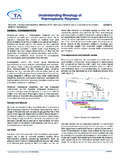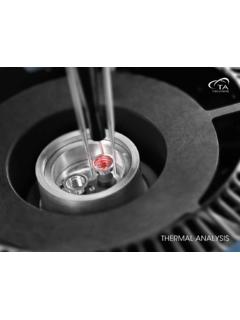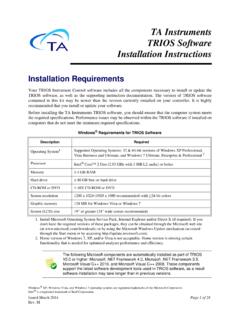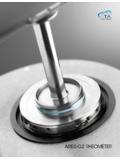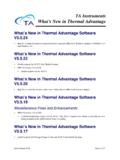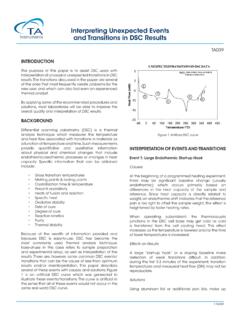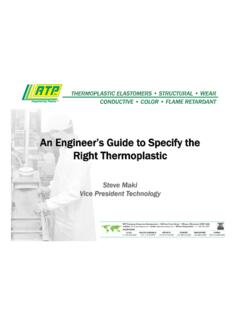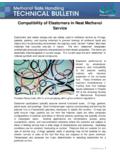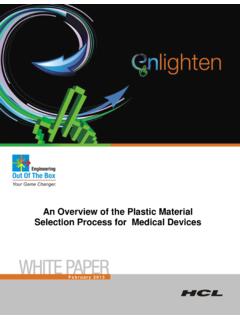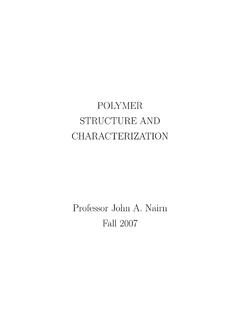Transcription of Thermal Analysis of Rubbers and Elastomers
1 Analysis of Rubbers and ElastomersMackenzie GeigerApplications ScientistSeptember 6, does it measure and what is it used for? Thermal Analysis is a series of complementary techniques to measure various properties of materials as a function of temperature and time Thermogravimetric Analysis (TGA) Weight loss, weight gain, compositional and Thermal stability of a material. [Sorption Analysis ] Provides information to aid in the interpretation of DSC data. Extremely complementary to DSC. Differential Scanning Calorimetry (DSC) Measures Heat Flow into or out of a sample Modulated DSC Separates Heat Flow into Heat Capacity, Reversing and Non Reversing Heat Flow Thermomechanical Analysis (TMA) Determines dimensional changes of a material, coefficient of Thermal expansion, glass transitionThermal Materials?
2 Iron and Steel Aluminum and other metals (Mg) Adhesives and Sealants Textiles / Leather Rubbers and Elastomers thermoplastic Polymers Composites Thermosets ans Resins Coatings and Paints Fluids and Lubricants Glass Other (electronics, fuel cell, gasoline, nano-materials, ceramics, sensors, etc.) Thermogravimetric AnalysisStandard and Hi-Res TGATM, TGA-MS, Decomposition and Lifetime Kinetics 2. Differential Scanning CalorimetryTechnique Overview, Conventional vs. Modulated DSC , Curing Analysis (TGA) Analysis (TGA) TGA measures amount and rate of weight change vs. temperature or time in a controlled atmosphere Used to determine composition and Thermal stability up to 1000 C (Q50 1200 C (Discovery TGA) & 1500 C (SDT) Characterizes materials that exhibit weight loss or gain due to decomposition, oxidation, or of Weight Change in TGA Weight Loss: Decomposition: The breaking apart of chemical bonds.)
3 Evaporation: The loss of volatiles with elevated temperature. Reduction: Interaction of sample to a reducing atmosphere (hydrogen, ammonia, etc). Desorption. Weight Gain: Oxidation: Interaction of the sample with an oxidizing atmosphere. of these are kinetic processes ( there is a rate at which they occur). of Elastomers in of Rubber Analysis02004006008001,0000255075100 Temperature ( C)Wt (%) Carbon Black5% Inert FillerSample weight: 30 mgProgram rate : 20 C/minAtmosphere : N , of Tire Oil( ) Polymer( ) Carbon( ) ( )TGA mg of Tire Rubber Compound20 C/min to 600 C in N220 C/min to 1000 C in air024681012 Deriv. Weight (%/min)020406080100 Weight (%)02004006008001000 Temperature ( C)Sample: Cured Tire Tread Rubber CompounSize: mg File: CURED TIRE TREAD RUBBER Date: 18-Nov-2005 12:06 Universal TA of Rubber in ( ) ( ) ( )-11 Deriv.
4 Weight (%/ C)20406080100120 Weight (%)2004006008001000 Temperature ( C)Sample: Rubber 10C/min N2 - Green ColorantSize: mg Rubber in ( ) ( ) ( )-20246 Deriv. Weight (%/ C)20406080100120 Weight (%)2004006008001000 Temperature ( C)Sample: Rubber 10C/min Air - Green ColorantSize: mg Rubber in Air vs ( ) ( ) ( ) ( ) ( ) ( ) C-20246 Deriv. Weight (%/ C)20406080100120 Weight (%)2004006008001000 Temperature ( C) Rubber 10 Cmin Air - Green Rubber 10 Cmin N2 - Green Fasterheatingratesduringperiodsofnoweigh tloss,andslowingdowntheheatingrateduring aweightloss thereforenotsacrificingasmuchtime Hi-ResTMTGA cangivebetterresolutionorfasterruntimes, andsometimesboth Rubber by TGA & Hi-Res Oil in a Rubber Compound by Hi-Res Gas Analysis (EGA) TGA measures weight changes (quantitative) Difficult to separate, identify, and quantify individual degradation products (off-gases) Direct coupling to identification techniques (Mass Spec, FTIR) reduces this of Styrene Butadiene Rubber (SBR)Deriv.
5 Weight (%/min)30507090 Weight (%)0100200300400500600700 Temperature ( C)Sample: SBRSize: mgComment: HeliumTGAFile: C:..\Bnl\Rubber\tga\SBR\ : Daniel ROEDOLFRun Date: 31-Dec-01 16:31 Instrument: AutoTGA 2950HR TA Instruments2mg sample He purge, 40 of Natural Rubber vs SBRN atural RubberStyrene 45 to 170 Natural RubberStyrene 100 to 200 Natural RubberStyrene Butadiene RubberSBR250 C400 C500 CDeriv. Weight (%/min)Weight (%)0100200300400500600700800 Temperature ( C)644878250 C400 C500 and Lifetime Polymer DecompositionConstant Gas Universal R(K) re temperatu Tmol) / (kJEnergy Activation Elexponentia-pre A min) / C( rate heating w herelnexp Polymer Decomposition Experimental Run TGA experiment on polymer at 4 different heating rates.
6 Use the same gas for each typically nitrogen or air. Obtain a temperature at an isoconversional point for example 2% weight loss for each heating rate Plot the ln of the heating rate ( ) versus 1/T (temperature units must be in Kelvin) Slope of the line is (- E/R). Multiply the slope of the line by ( x 10-3) to obtain the activation energy in Kinetics1000/T (K) Kinetics Isoconversion Kinetics -Estimated LifetimeTEMPERATURE ( C) (K)ESTIMATED LIFE (hr.)2602803003203403601 century1 decade1 week1 dayESTIMATED LIFETA Instruments Application Note TA125 Estimation of Polymer Lifetime by TGA Decomposition Scanning Calorimetry (DSC) and Modulated DSC (MDSC) Scanning Calorimetry (DSC) Differential Scanning Calorimetry (DSC) is most popular Thermal Analysis technique DSC measures endothermic and exothermic transitions as a function of temperature Endothermic heat flows into a sample Exothermic heat flows out of the sample Used to characterize polymers (thermosets, thermoplastics, Elastomers )
7 Also used with pharmaceuticals, foods/biologicals, organic chemicals and inorganics Transitions measured include Tg, melting, crystallization, curing and cure kinetics, onset of oxidation and heat is Differential Scanning Calorimetry? Calorimetry is a technique for determining the quantity of heat that is either absorbed or released by a substance undergoing a physical or chemical change. A DSC measures the difference in Heat Flow Rate between a sample and inert reference as a function of time and temperature. Heat Flux DSC Cell SchematicReference SensorAn empty pan on the reference sensor should react similarly to the pan on the sample sensor, thus canceling out any pan contributionSample SensorHeat absorbedby the sample gives an endothermic responseHeat releasedby the sample gives an exothermic Heat Flowt)(T,dtdT Cp dtdHf Heat CapacityGlass TransitionKineticCrystallizationCure UpExo UpGlass Transition, Tg(Half height)
8 CEndothermic Heat Flow Heat Absorbed by SubstanceEndothermic Events Glass transition Melting Evaporation/ volatilization Enthalpicrecovery Polymorphic transitions Some Heat FlowHeat Released by SubstanceExothermic Events Crystallization Cure reactions Polymorphic transitions Oxidation DecompositionExo UpExo DSC TransitionsTemperatureHeat Flow -> exothermicGlassTransitionCrystallization MeltingCross-Linking(Cure)OxidationOrDec ompositionComposite Terephthalate (PET)Second HeatFirst Flow (W/g)2060100140180220260 Temperature ( C) Does MDSC Measure? MDSC separates the Total heat flow of DSC into two parts based on the heat flow that does and does not respond to a changing heating rate MDSC applies a changing heating rate on top of a linear heating rate in order measure the heat flow that responds to the changing heating rate In general, only heat capacity and melting respond to the changing heating rate The Reversing and Non-reversing signals of MDSC should neverbe interpreted as the measurement of reversible and nonreversible Heat Flow and Heat Capacity-6-4-202 Rev Heat Flow (mW)-12-8-404 Rev Cp (J/(g C))0481216 Deriv.
9 Modulated Temperature ( C/min)-8-6-4-202 Modulated Heat Flow (mW)-50050100150200250300350 Temperature ( C) Exo UpUniversal TA Enthalpic Recovery Evaporation Crystallization Thermoset Cure Denaturation Decomposition Some MeltingMDSC Heat Flow SignalsTotal Heat Flowt)(T,dtdT Cp dtdHf Reversing Heat FlowNon-Reversing Heat Flow Heat Capacity Glass Transition Most Melting All MDSC Heat Flow SignalsQuenched PET Blend -Conventional ( C)50100150200250 Heat Flow (W/g)first heat on molded part(Curve shifted on Y axis to avoid overlap)second heat after 10 C/min C (H) mg sample, nitrogen purge 10 C/minute heating Blend sample nitrogen purge 2 C/minute heating rate, 1 C amplitude, 60 second periodfirst heat on molded part PET TgABS Temperature ( C)4060100120140 Heat Flow (mW) ( ) Nonrev.
10 Heat Flow (W/g)( ) Rev. Heat Flow (W/g) C+ C (H) C (H) Tgby C(H)Elastomer - - 10 Flow (mW)-80-60-40-20020 Temperature ( C) Exo UpUniversal TA Tg by DSC & C(H) C(H)Elastomer - - @3 Heat Flow (mW) Flow (mW)-80-60-40-20020 Temperature ( C) Exo UpUniversal TA properties of crosslinking reactions ,itisalmostalwaysaccompaniedbyareleaseof heat. ThereactionscanbeeasilymonitoredusingaDS C. Heat of reaction Residual cure Glass transition Heat capacity Crosslinking reactions are generally accompanied by a sharp change in the material s mechanical properties. Increase in modulus that may be accompanied by shrinkage. The reactions can thus be monitored using a Thermo-mechanical Analyzer (TMA)/Dynamic Mechanical Analyzer (DMA)/Rheometer.
